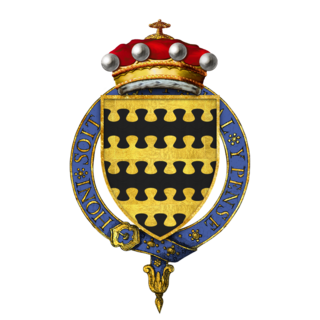Related Research Articles
Sir James Tyrrell was an English knight, a trusted servant of king Richard III of England. He is known for confessing to the murders of the Princes in the Tower under Richard's orders. William Shakespeare portrays Tyrrell as the man who organises the princes' murder in his 1593 play Richard III.

William Blount, 4th Baron Mountjoy, KG, of Barton Blount, Derbyshire, was an extremely influential English courtier, a respected humanistic scholar and patron of learning. He was one of the most influential and perhaps the wealthiest English noble courtier of his time. Mountjoy was known internationally as a humanist writer and scholar and patron of the arts.

Sir William Petre was Secretary of State to three successive Tudor monarchs, namely Kings Henry VIII, Edward VI and Queen Mary I. He also deputised for the Secretary of State to Elizabeth I.

Sir John Tyrrell, of Heron in the Essex parish of East Horndon, was an English landowner, lawyer, administrator, and politician who was chosen three times as Speaker of the House of Commons.

Sir Edmund Shaa or Shaw was a London goldsmith, Sheriff of London in 1475 and Lord Mayor of London in 1482. Shaa lent money to Edward IV and, as mayor, was extensively involved in the coronation of Edward IV's brother Richard III. He was later knighted and made a member of the Privy Council.

John Petre, 1st Baron Petre was an English peer who lived during the Tudor period and early Stuart period. He and his family were recusants — people who adhered to the Roman Catholic faith after the English Reformation. Nevertheless, Lord Petre was appointed to a number of official positions in the county of Essex.
Richard Rich was a London mercer, and Sheriff of that city in 1441.

Sir John Mundy was a member of the Worshipful Company of Goldsmiths and was Lord Mayor of London in 1522.
Christopher Brooke was an English poet, lawyer and politician who sat in the House of Commons between 1604 and 1626.
Sir Henry Keble was a grocer and Lord Mayor of London in 1510, in the second year of King Henry VIII's reign. Sir Henry was a leading grocer in London. He was a Merchant of the Staple in Calais. He was originally from Coventry, but had settled in the parish of St Mary Aldermary. He was six times Master of the Grocers' Company. He left bequests to the company, and gave £1,000 to rebuild the church at St Mary Aldermary.
William Ayloffe, was an English justice of the Queen's Bench.

Sir Edmund Walsingham of Scadbury Hall, Chislehurst in Kent, was a soldier, Member of Parliament, and Lieutenant of the Tower of London during the reign of King Henry VIII.
Sir George Harper, JP was an English politician. He was Member of Parliament for Kent.
John Browne II, of London and Horton Kirby, Kent, was Warden of the Mint and MP for Aldborough.
Sir Richard Baker, was an English politician.
Sir Michael Dormer was a wealthy member of the Mercers' Company, and Lord Mayor of London in 1541.
Anthony Stapleton was a Tudor lawyer, member of parliament, and Clerk of the City of London.
Sir John Shaa or Shaw was a London goldsmith. He served as engraver and later joint Master of the Mint, and as Sheriff and Lord Mayor of London. While Lord Mayor he entertained ambassadors from Scotland, and was among those who welcomed Catherine of Aragon to England. He is mentioned in a poem by William Dunbar.
Gertrude Tyrrell was a 16th-century English noblewoman.
Anne Browne [AN BROWN], was a Tudor noblewoman known for her prominence in the English court during the 16th century. Born around 1495, Anne Browne lived through a significant period in English history, witnessing the tumultuous events of the Tudor era. Her life spanned the reigns of several monarchs, including Henry VII, Henry VIII, Edward VI, Mary I, and Elizabeth I, allowing her a unique perspective on the changing political and social landscape of the time. Browne's influence and status within the noble circles of Tudor England afforded her a notable position in historical records. She died on 10 March 1582.
References
- Essex Archaeological Society (1884). "Annual Meeting". Transactions of the Essex Archaeological Society. New Series. II. Colchester: W. Wiles. Retrieved 8 July 2013.
- Beaven, Alfred B. (1913). The Aldermen of the City of London Temp. Henry III – 1912. Vol. II. London: Eden Fisher & Company. Retrieved 8 July 2013.
- Benton, Philip (1888). The History of Rochford Hundred. Vol. II. Rochford: A. Harrington. Retrieved 8 July 2013.
- Brewer, J.A., ed. (1862). Letters and Papers, Foreign and Domestic, of the Reign of Henry VIII. Vol. I. London: Longman, Green. ISBN 9781554295883 . Retrieved 8 July 2013.
- Brown, James Roberts (1888). "Jno. and Wm. Browne, Sheriffs and Lord Mayors of London". Notes and Queries. 7th Series. V. London: John C. Francis: 151–153. Retrieved 8 July 2013.
- Fisher, P. (1668). The Catalogue of Most of the Memorable Tombes. London. Retrieved 8 July 2013.
- Cromwell, T.K. (1818). Excursions in the County of Essex. Vol. I. London: Longman, Hurst. Retrieved 8 July 2013.
- Metcalfe, Walter C., ed. (1878). The Visitations of Essex. Vol. XIII. London: Harleian Society. Retrieved 8 July 2013.
- Metcalfe, Walter C., ed. (1887). The Visitations of Northamptonshire. London: Harleian Society. p. 167 . Retrieved 8 July 2013.
- Richardson, Douglas (2011). Everingham, Kimball G. (ed.). Magna Carta Ancestry: A Study in Colonial and Medieval Families. Vol. I (2nd ed.). Salt Lake City. ISBN 978-1449966379.
{{cite book}}: CS1 maint: location missing publisher (link) - Fretton, William George (1890). Sharpe, Thomas (ed.). Calendar of Wills Proved and Enrolled in the Court of Husting, London, A.D. 1258 – A.D. 1688, Part II. Reginald R. Sharpe (2nd ed.). London: John Francis. Retrieved 8 July 2013.
- Stow, John (1876). A Survey of London. London: Chatto & Windus. p. 111 . Retrieved 8 July 2013.
- Tucker, P. (2004). "Shaw, Sir Edmund (d. 1488)". Oxford Dictionary of National Biography (online ed.). Oxford University Press. doi:10.1093/ref:odnb/25248.(Subscription or UK public library membership required.)The first edition of this text is available at Wikisource: . Dictionary of National Biography . London: Smith, Elder & Co. 1885–1900.